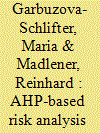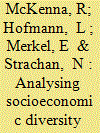|
|
|
Sort Order |
|
|
|
Items / Page
|
|
|
|
|
|
|
| Srl | Item |
| 1 |
ID:
150020


|
|
|
|
|
| Summary/Abstract |
The register of the Dutch social housing stock was analysed, containing 300.000 dwellings, renovated between 2010 and 2013. The main objective was twofold: to evaluate the performance gap in these dwellings before and after the renovation and to establish what renovation measures achieve the highest reduction of consumption, particularly in practice (actual savings). The results showed large performance gaps in dwellings with low R and high U values, local heating systems, changes from a non-condensing into a condensing boiler and upgrades to a natural ventilation system. Regarding the actual effectiveness of renovation measures, replacement of old gas boilers with more efficient ones yields the highest energy reduction, followed by deep improvements of windows. Installing mechanical ventilation yields a small reduction compared to other measures, but still much larger than theoretically expected. The paper shows once more that the calculation method currently in use cannot be considered accurate if compared to actual consumption. The study demonstrated that unrealistic theoretical efficiencies of heating systems and insulation values are causing a part of the performance gap. Nowadays, large datasets of buildings thermal performance and actual consumption offer an opportunity to improve these misconceptions.
|
|
|
|
|
|
|
|
|
|
|
|
|
|
|
|
| 2 |
ID:
150043


|
|
|
|
|
| Summary/Abstract |
The energy sector depends on water in all phases of its life-cycle, including raw material extraction, power plant cooling, irrigation of biofuel crops and directly in hydropower generation. In the coming decades, several regions of the world are expected to experience a decrease in water resource availability, in part due to climate change. The dependence of the energy sector on water resources calls for an active effort to adapt to the possible scenarios. This paper presents a novel model that addresses the direct impacts of regional and temporal water shortages on energy operation and investment decisions. The paper investigates the costs and benefits of adapting the energy sector to climate-induced water scarcity. The results show that the increase in costs for an energy plan that considers future water stress is relatively small as compared to one which ignores it. A plan which ignores water constraints, however, may lead to significant economic damages when actually exposed to water shortages. The results also highlight the value of the availability of water for the energy sector, which is significantly higher than existing prices. The paper concludes that the potential benefits to be gained by integrating energy and water models can be considerable.
|
|
|
|
|
|
|
|
|
|
|
|
|
|
|
|
| 3 |
ID:
150067


|
|
|
|
|
| Summary/Abstract |
Understanding and properly managing risks that could potentially affect the target- and performance-based profits of energy performance contracting (EPC) projects are essential. It is particularly important for the establishment and success of energy service companies (ESCOs) acting in the vulnerable environment of the vast but highly energy-inefficient Russian market. This study systematically explores common risk factors and causes of risk associated with EPC projects executed in three Russian sectors: (1) industrial; (2) housing and communal services; and (3) public. Several interviews with the Russian EPC experts were accomplished and a qualitative risk assessment by using an analytic hierarchy process (AHP) approach. The data were obtained from a web-based questionnaire survey conducted among Russian EPC project executors. For each focus sector, a specific preference-based ranking of the identified risk factors and causes of risk was derived. The AHP results show that causes of risk related to the financial and regulatory aspects contribute most to the riskiness of EPC projects performed in all three focus sectors in Russia, calling for the special attention of EPC policy- and business-makers. Due to sectorial particularities and different actors involved, we conclude that there is a need for elaboration of sector-specific contractual schemes for EPC projects.
|
|
|
|
|
|
|
|
|
|
|
|
|
|
|
|
| 4 |
ID:
150019


|
|
|
|
|
| Summary/Abstract |
Adequately accounting for interactions between Low Carbon Technologies (LCTs) at the building level and the overarching energy system means capturing the granularity associated with decentralised heat and power supply in residential buildings. The approach presented here adds novelty in terms of a realistic socioeconomic differentiation by employing dwelling/household archetypes (DHAs) and neighbourhood clusters at the Output Area (OA) level. These archetypes are combined with a mixed integer linear program (MILP) to generate optimum (minimum cost) technology configurations and operation schedules. Even in the baseline case, without any LCT penetration, a substantial deviation from the standard load profile (SLP) is encountered, suggesting that for some neighbourhoods this profile is not appropriate. With the application of LCTs, including heat pumps, micro-CHP and photovoltaic (PV), this effect is much stronger, including more negative residual load, more variability, and higher ramps with increased LCT penetration, and crucially different between neighbourhood clusters. The main policy implication of the study is the importance of understanding electrical load profiles at the neighbourhood level, because of the consequences they have for investment in the overarching energy system, including transmission and distribution infrastructure, and centralised generation plant. Further work should focus on attaining a superior socioeconomic differentiation between households.
|
|
|
|
|
|
|
|
|
|
|
|
|
|
|
|
| 5 |
ID:
150031


|
|
|
|
|
| Summary/Abstract |
In this paper, we identify and analyze parameters that determine the profitability of wind power operators in the German market premium model. Based on an empirical analysis of different German wind power profiles from 2007 to mid-2012, we are able to show that the profitability significantly depends on the correlation of the wind power portfolio with the overall wind power feed-in and prediction error in Germany. Significant differences between the wind forecast errors clearing cost of the analyzed portfolios can be identified. Our analysis shows that a wind power operator would profit in most cases from a reduced forecast error, which could be achieved through an improved forecast model and an increased share of the intraday cleared error. Furthermore significant locational portfolio advantages and disadvantages can be identified when comparing the different market values. In general, the empirical analysis shows that a premium of 3.5 €/MWh is suitable to cover the cost of an imperfect forecast. Taking further into account that for 2012 a premium of 12 €/MWh was granted; the direct marketing option can be evaluated as highly attractive, which is furthermore indicated by the rapid increase of the directly marketed wind power and photovoltaic generation.
|
|
|
|
|
|
|
|
|
|
|
|
|
|
|
|
| 6 |
ID:
150068


|
|
|
|
|
| Summary/Abstract |
Electricity sector has been transformed from state-owned monopolistic utilities to competitive markets with an aim to promote incentives for improving efficiency, reducing costs and increasing service quality to customers. One of the cardinal assumptions of the liberalized and competitive electricity markets is the rational actor, and decision-makers are assumed to make the best decisions that maximize their utility. However, a vast literature on behavioral economics has shown the weakness of economic theory in explaining and predicting individuals’ decision-making behavior. This issue is quite important for competition in electricity markets in which consumers’ preferences have a significant role. Despite its importance, this issue has almost been neglected in Turkey, which has taken major steps in electricity sector restructuring. Therefore, this paper aims to examine switching and demand response behavior in Turkish electricity market by using multiple correspondence and panel data analysis, and findings are discussed in light of the neoclassical and behavioral economics literature. Analyses’ results show that consumers’ switching and demand response behavior is consistent with the neoclassical literature to some extent; however, behavioral factors are also affecting consumers’ decisions. Furthermore, there are systemic problems that hinder effective functioning of the electricity market and restrict competition.
|
|
|
|
|
|
|
|
|
|
|
|
|
|
|
|
| 7 |
ID:
150018


|
|
|
|
|
| Summary/Abstract |
The ‘Dieselgate’ emissions scandal has highlighted long standing concerns that the performance gap between ‘real world’ and'official’ energy use and pollutant emissions of cars is increasing to a level that renders ‘official’ certification ratings virtually ineffective while misleading consumers and damaging human health of the wider population. This paper aims to explore the scale and timing of historic and future impacts on energy use and emissions of the UK car market. To achieve this aim it applies a bespoke disaggregated model of the transport-energy-environment system to explore the impacts of retrospective and future policy scenarios on the UK car market, trade-offs between greenhouse gas and air quality emissions, and fuel use and associated tax revenues. The results suggest that the impacts on human health of ‘real world’ excess NOX emissions in the UK are significant. Future ‘low diesel’ policies can have significant air quality benefits while showing few (if any) carbon disbenefits, suggesting future car pricing incentives may need to be rebalanced taking more account of effects of local air pollution. Car pricing incentives are however unlikely to transform the car market without additional market changes, industry push, infrastructure investment and policy pull aimed at cleaner, lower carbon vehicles.
|
|
|
|
|
|
|
|
|
|
|
|
|
|
|
|
| 8 |
ID:
150055


|
|
|
|
|
| Summary/Abstract |
This paper studies various options to support allowance prices in the EU Emissions Trading System (ETS), such as adjusting the cap, an auction reserve price, and fixed and variable carbon taxes in addition to the EU ETS. We use a dynamic computable general equilibrium model that explicitly allows for allowance banking and for a detailed cost-effectiveness analysis at the EU Member State level. We find that tightening the cap provides an ad hoc solution to the fundamental issue of the robustness of the effective carbon price, while introducing a price component to the ETS brings structural carbon price support in times of negative demand shocks for emission allowances. These price-based policies still benefit from the intertemporal flexibility through the banking provision in the EU ETS by re-allocating emissions over time with stronger emission reductions in early years and emission increases in later years. A higher emission price has a larger negative impact on the new Member States' economies than on other Member States. Furthermore, introducing a carbon tax in addition to the EU ETS decreases the price of allowances, resulting in welfare gains for net buyers of allowances while net sellers are worse off.
|
|
|
|
|
|
|
|
|
|
|
|
|
|
|
|
| 9 |
ID:
150048


|
|
|
|
|
| Summary/Abstract |
A common strategy for reducing greenhouse gas (GHG) emissions from energy use is to increase the supply of low-carbon alternatives. However, increasing supply tends to lower energy prices, which encourages additional fuel consumption. This “fuel market rebound effect” can undermine climate change mitigation strategies, even to the point where efforts to reduce GHG emissions by increasing the supply of low-carbon fuels may actually result in increased GHG emissions. Here, we explore how policies that encourage the production of low-carbon fuels may result in increased GHG emissions because the resulting increase in energy use overwhelms the benefits of reduced carbon intensity. We describe how climate change mitigation strategies should follow a simple rule: a low-carbon fuel with a carbon intensity of X% that of a fossil fuel must displace at least X% of that fossil fuel to reduce overall GHG emissions. We apply this rule to the United States Renewable Fuel Standard (RFS2). We show that absent consideration of the fuel market rebound effect, RFS2 appears to reduce GHG emissions, but once the fuel market rebound effect is factored in, RFS2 actually increases GHG emissions when all fuel GHG intensity targets are met.
|
|
|
|
|
|
|
|
|
|
|
|
|
|
|
|
| 10 |
ID:
150058


|
|
|
|
|
| Summary/Abstract |
Electricity consumption growth in China has experienced radical adjustment from high speed to medium speed with the advent of new economy normal. However, the investment enthusiasm on coal power remains unabated and leads to continuous operation efficiency deterioration in recent years. In this paper, we quantify the rational capacity and potential investment of coal power in China during the 13th FYP period (2016–2020). By employing power planning model and fully considering the power sector's contribution in the 15% non-fossil primary energy supply target by 2020, we estimate that the reasonable capacity addition space of coal power ranges between 50 GW and 100 GW, depending on the expected range of demand growth. We find that if all the coal power projects submitted for Environmental Impact Assessment (EIA) approval were put into operation in 2020, capacity excess would reach 200 GW. Such huge overcapacity will bring forth disastrous consequences, including enormous investment waste, poor economic performance of generators and more importantly, delay of low-carbon energy transition. Finally, policy recommendations are proposed to address this issue.
|
|
|
|
|
|
|
|
|
|
|
|
|
|
|
|
| 11 |
ID:
150050


|
|
|
|
|
| Summary/Abstract |
The question whether coexistence of marine renewable energy (MRE) projects and marine protected areas (MPAs) is a common spatial policy in Europe and how a number of factors can affect it, has been addressed by empirical research undertaken in eleven European marine areas. Policy drivers and objectives that are assumed to affect coexistence, such as the fulfillment of conservation objectives and the prioritization of other competing marine uses, were scored by experts and predictions were crosschecked with state practice. While in most areas MRE-MPA coexistence is not prohibited by law, practice indicates resistance towards it. Furthermore expert judgment demonstrated that a number of additional factors, such as the lack of suitable space for MRE projects and the uncertainty about the extent of damage by MRE to the MPA, might influence the intentions of the two major parties involved (i.e. the MRE developer and the MPA authority) to pursue or avoid coexistence. Based on these findings, the interactions of these two players are further interpreted, their policy implications are discussed, while the need towards efficient, fair and acceptable MRE-MPA coexistence is highlighted.
|
|
|
|
|
|
|
|
|
|
|
|
|
|
|
|
| 12 |
ID:
150026


|
|
|
|
|
| Summary/Abstract |
This article examines what would have to change in the Brazilian regulatory framework in order to make utilities profit from energy efficiency and the integration of resources, instead of doing so from traditional consumption growth, as it happens at present. We argue that the Brazilian integrated electric sector resembles a common-pool resources problem, and as such it should incorporate, in addition to the centralized operation for power dispatch already in place, demand side management, behavioral strategies, and smart grids, attained through a new business and regulatory model for utilities. The paper proposes several measures to attain a more sustainable and productive electricity distribution industry: decoupling revenues from volumetric sales through a fixed maximum load fee, which would completely offset current disincentives for energy efficiency; the creation of a market for negawatts (saved megawatts) using the current Brazilian mechanism of public auctions for the acquisition of wholesale energy; and the integration of technologies, especially through the growth of unregulated products and services. Through these measures, we believe that Brazil could improve both energy security and overall sustainability of its power sector in the long run.
|
|
|
|
|
|
|
|
|
|
|
|
|
|
|
|
| 13 |
ID:
150027


|
|
|
|
|
| Summary/Abstract |
The demand for residential heat (RH) through a district heating system (DHS) has been and will be expanded in Korea due to its better performance in energy efficiency and the abatement of greenhouse gas emissions than decentralized boilers. The purposes of this paper are two-fold. The first is to obtain the demand function for DHS-based RH in Korea and investigate the price and income elasticities of the demand employing the quarterly data covering the period 1988–2013. The short-run price and income elasticities are estimated as −0.700 and 0.918, respectively. Moreover, the long-run elasticities are −1.253 and 1.642, respectively. The second purpose is to measure the consumption benefits of DHS-based-RH employing the economic theory that they are the sum of the actual payment and consumer surplus for the consumption. Considering that the average price and estimated consumer surplus of the DHS-based RH use in 2013 are computed to be KRW 87,870 (USD 84.1) and KRW 62,764 (USD 60.1) per Gcal, the consumption benefits of the DHS-based RH are calculated to be KRW 150,634 (USD 144.2) per Gcal. This information can be beneficially utilized to conduct an economic feasibility study for a new DHS project related to RH supply.
|
|
|
|
|
|
|
|
|
|
|
|
|
|
|
|
| 14 |
ID:
150032


|
|
|
|
|
| Summary/Abstract |
To fulfill its Copenhagen pledges to control carbon emissions and mitigate climate change, China plans to establish a nationwide emissions trading scheme (ETS) in 2016. This paper develops a multi-sector dynamic computable general equilibrium model with an ETS module to study the appropriate ETS policy design, including a carbon cap, permit allocation and supplementary policies (e.g., penalty policies and subsidy policies). The main results are as follows. (1) To achieve China's Copenhagen pledge, the equilibrium nationwide carbon price is observed to be between 36 and 40 RMB yuan per metric ton. (2) The ETS policy has a cost-effective mitigation effect by improving China's production and energy structures with relatively little economic harm. (3) Various ETS sub-policies should be carefully designed to balance economic growth and carbon mitigation. In particular, the carbon cap should be set according to China's Copenhagen pledge. A relatively large distribution ratio of free permits, the output-based grandfathering rule for free permits, a penalty price (on illegitimate emissions) slightly above the carbon price, and a sufficient subsidy (from ETS revenue) are strongly recommended in the early stages to avoid significant economic loss. These designs can be adjusted in later stages to enhance the mitigation effect.
|
|
|
|
|
|
|
|
|
|
|
|
|
|
|
|
| 15 |
ID:
150036


|
|
|
|
|
| Summary/Abstract |
Commercial fishermen are arguably the stakeholder group most likely to be directly impacted by the expansion of the marine renewable energy (MRE) sector. The potential opposition of fishermen may hinder the development of MRE projects and the provision of benefit schemes could to enhance acceptance. Benefit schemes refer to additional voluntary measures that are provided by a developer to local stakeholders. The aim of this study is to explore the issue of the provision of benefit packages to local fishing communities and financial compensation measures for fishermen who may be impacted by MRE projects. Semi-structured interviews were conducted with fourteen fishermen from three separate case study sites around the island of Ireland where MRE projects were being developed. In addition, ten company fisheries liaison officers (CFLOs) who have worked on MRE projects in the UK and Ireland were also interviewed. The interviews were analysed under the headings of local employment, benefits in kind, compensation and community funds and ownership of projects. Analysis shows that there is uncertainty among fishermen over whether they would benefit or gain employment from MRE. Provision of re-training schemes and preferential hiring practices could be used by MRE developers to reduce this uncertainty. There was also agreement between fishermen and CFLOs on the need for the provision of an evidence-base and a standard approach for the calculation of disruption payments. A formal structure for the provision of benefit schemes for fishermen would be useful. Furthermore, schemes that provide a range of benefits to fishermen and other stakeholders over the lifetime of a MRE project are more likely to be successful at enhancing acceptance.
|
|
|
|
|
|
|
|
|
|
|
|
|
|
|
|
| 16 |
ID:
150069


|
|
|
|
|
| Summary/Abstract |
We investigate lower than expected capacity factors of Combined Heat and Power plants using a publicly available dataset of hourly performance for plants in the state of New York. Low utilization of a CHP indicates underperformance. We examine possible causes of this underperformance including economic arbitrage, poor maintenance and operational practices, oversizing of plants, and reliability and resiliency needs. Based on seasonal and weekday/weekend capacity factor averages, we find that there is not enough evidence to support the economic arbitrage cause. Out of 99 plants in the dataset, 64 plants have average capacity factor below 60%, indicating they are either oversized and/or poorly maintained. This suggests that the current practice of one-time fixed incentive ($/kW) favors investment in capacity with no incentive for utilization (unlike a production credit which incentivizes generation $/kW h). From a policy perspective, this paper recommends better pre-engineering assessment for correct sizing, as well as revision of incentives based on performance. Additional information should be collected so that a more accurate ongoing analysis of the societal benefits of CHP projects can be made. Lastly, the energy efficiency gap may be smaller than is commonly assumed and other options should be explored to meet energy efficiency goals.
|
|
|
|
|
|
|
|
|
|
|
|
|
|
|
|
| 17 |
ID:
150023


|
|
|
|
|
| Summary/Abstract |
Increasing energy efficiency is a cornerstone of policy initiatives to tackle climate change and increase corporate sustainability. Convincing people to drive more fuel-efficiently (“eco-driving”) is often an integral part of these approaches, especially in the transport sector. But there is a lack of studies on the long-term persistence and potential interaction of the effects of incentives and training on energy conservation behavior in general and eco-driving behavior in particular. We address this gap with a twelve months long natural field experiment in a logistics company to analyze the time-dependent and potentially interacting effects of rewards and theoretical training for eco-driving on fuel consumption in a real-world setting. We find an immediate reduction of fuel consumption following the introduction of a non-monetary reward and an attenuation of this effect over time. Theoretical eco-driving training shows no effect, neither short-term nor long-term, highlighting the often neglected necessity to include practical training elements. Contrary to common assumptions, the interaction of incentives and theoretical training does not show an additional reduction effect. Our results demonstrate the difficulty of changing engrained behavior and habits, and underline the need for a careful selection and combination of interventions. Policy implications for public and private actors are discussed.
|
|
|
|
|
|
|
|
|
|
|
|
|
|
|
|
| 18 |
ID:
150028


|
|
|
|
|
| Summary/Abstract |
In this paper I use quarterly and monthly data from 1994 to 2014 to test if OPEC acts as a cartel, and therefore, it affects oil prices through members' coordination. I use Engle and Granger two-step approach, Johansen cointegration test and Autoregressive Distributed Lag (ARDL) bounds testing approach of cointegration to examine the long-run relation between OPEC production and each member's production as an evidence of coordination. Besides, I apply Granger causality and Toda and Yamamoto tests to check the direction of causality between the OPEC production and oil prices (U.K. Brent and Dubai Fateh). The findings show no evidence of cointegration between the production of the members and that of OPEC, indicating no cartel behavior exists. Moreover, the results show that OPEC production does not cause oil prices; rather it is the other way around.
|
|
|
|
|
|
|
|
|
|
|
|
|
|
|
|
| 19 |
ID:
150053


|
|
|
|
|
| Summary/Abstract |
This paper investigates the role that the building of two new power stations, Medupi and Kusile, will play in facilitating future economic activity in South Africa. We use a dynamic computable general equilibrium (CGE) model to estimate the economy-wide effects of these new power stations. Our simulation results also provide insight into how much the local economy has lost due to inadequate electricity supply in the period leading up to the construction of Medupi and Kusile. We find that the decision to build additional power generation capacity was necessary and justified, and that the failure to sooner recognise the need for expansion of the country's electricity generation capacity and subsequent delays in commissioning Medupi and Kusile, likely cost the economy over R110bn in lost production. Additional analysis, in which a further two-year delay in the construction of Medupi and Kusile is simulated, shows that such an event will cause the economy to perform below baseline projections up to 2022.
|
|
|
|
|
|
|
|
|
|
|
|
|
|
|
|
| 20 |
ID:
150056


|
|
|
|
|
| Summary/Abstract |
Strong rental protection in the affordable housing market often prohibits landlords from charging rental premiums for energy-efficient dwellings. This may impede (re)development of energy efficient affordable housing. In the Netherlands, affordable housing institutions regularly sell dwellings from their housing stock to individual households. If they can sell energy efficient dwellings at a premium, this may stimulate investments in the environmental performance of homes.
|
|
|
|
|
|
|
|
|
|
|
|
|
|
|
|
|
|
|
|
|